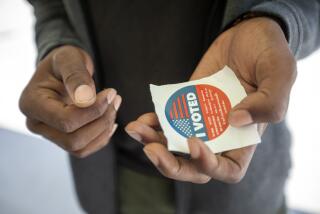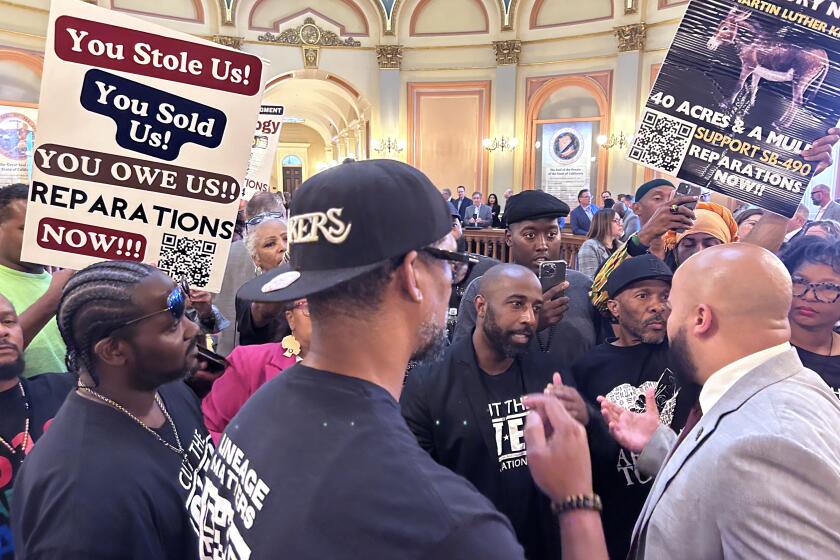How California is preparing for in-person voting this year due to coronavirus

- Share via
SACRAMENTO — Even as California elections officials prepare to mail ballots to all of the state’s 21 million voters this fall, they do so with the expectation that some portion of the electorate will still choose to participate in person during the pandemic, requiring a delicate balance between voting rights and public health.
“We are preparing for, I think, the most unprecedented election in modern history,” Secretary of State Alex Padilla said. “This is an all hands on deck moment.”
After Gov. Gavin Newsom issued an executive order in June outlining new voting location rules — a plan ratified on Thursday by the Legislature — county officials have scrambled to determine how many in-person locations they can muster and how many days they can keep them open. Added to that is uncertainty over whether there will be enough short-term workers who are willing to work more than a single day and also enforce strict coronavirus safety measures.
“I think all counties have struggled a bit,” said Brandi Orth, registrar of voters in Fresno County and president of the state association of elections officials. “It is an extreme, additional lift.”
Few problems are more pressing than finding locations that meet strict guidelines for physical distancing. The tradition of cramming ballot-marking booths into a neighbor’s garage or a room at a senior care facility is, at least for this election, a nonstarter.
A detailed set of instructions written by state officials last month urges at least six feet of space between voting equipment and voter check-in locations. In some tight spots, the guide urges the use of plexiglass partitions. And marked spaces on the floor, similar to those in retail and grocery stores, should be used for voters waiting to cast a ballot.
“There will be lines because you just can’t physically put all of those people together,” Orth said.
To lessen the chance of long lines, state officials have encouraged counties to offer four days of in-person voting, from Saturday, Oct. 31 through election day. But this too presents problems for communities that have traditionally relied on places of worship or a variety of public buildings for voting locations.
With physical space and extra time as the primary requirements, some counties are far from securing what they need. Janna Hayes, a spokesperson for Sacramento County, said elections officials have so far found fewer than half the number of voting locations used in the March presidential primary.
“We continue to need community partners, businesses — both public and private locations — school districts, to step up and offer services and locations,” Hayes said.
Fifteen California counties, including Sacramento, Los Angeles and Orange, had opted for multi-day voting before the outbreak of the coronavirus. Voters in those counties can use in-person sites for a variety of elections services. But most are unlikely to offer 15 days of in-person voting and focus time and resources on the final leg of the election cycle instead.
“When you look at the data, voters’ habits do not change,” said Neal Kelley, the registrar of voters in Orange County. “They wait until the weekend before and they go out.”
Kelley says his voting centers will be open for five days — in part, to limit the potential coronavirus risks to election workers.
“It doesn’t make sense to expose my staff,” he said.
Election workers will be expected to follow strict public health rules, including sanitizing voting equipment at each site and wearing gloves and other protective equipment.
But that won’t be required of voters.
“Election workers must not turn a voter away for lack of face covering,” says the 52-page guide compiled by Padilla’s office for local officials. “The right to vote takes precedence.”
Voters who arrive without a mask will be offered one, as will anyone wearing a mask with a slogan of support for a candidate, a violation of rules banning electioneering at the polls. And for those who refuse a mask, election officials are expected to designate at least one voting booth far from the others.
With mask mandates sparking angry outbursts in a number of California communities, election workers will be trained in how to limit conflict and ensure safety at the voting site.
“Election workers should be provided with instructions to call the county elections office if they feel threatened or intimidated, if voters feel threatened or intimidated, or if a disturbance of any kind occurs,” the state guide says. “Election workers should be instructed to call local law enforcement first if they believe the safety of any person in the polling place is in jeopardy.”
In Orange County, a hotbed of anti-mask sentiment, Kelley says he has ordered some 300,000 masks for voting locations and is producing training videos for election workers with detailed instructions on easing any tensions that arise.
“The last thing I want is our staff having to get into a conflict,” he said.
Coronavirus precautions will also require a new focus on protecting paper ballots. State officials are asking local workers to post a reminder on signs inside voting locations: “Your ballot is fragile; make sure your hands are dry and your sanitizer has evaporated.”
In-person voting is not the only challenge for local election officials who expect high turnout and a deluge of absentee ballots dropped off at local drop boxes and election offices or sent in the mail. A special provision has been made for the November election allowing ballots postmarked by election day to be counted even if they arrive 17 days late.
Election workers, who often work in pairs to retrieve ballots from drop boxes as a security measure, will be asked not to travel together and instead follow one another in their own cars. Those paired workers should be kept together to avoid additional mixing, the state guide says, and the keys that open the drop boxes should be disinfected.
Additional space to process and count ballots is also needed, state officials said. In Fresno County, Orth said she’s already secured more warehouse space to spread her staff out for the ballot counting process.
There are also fears that election workers might contract COVID-19 either right before or after the election, leading to a slowdown in work or the need for well-trained backup employees.
Orth’s team got a preview of what that could look like late last month, after three Fresno County government employees who assist with candidate campaign documents had to quarantine at home for up to two weeks after possible virus exposure.
“We worked long hours to make up for their absence,” she said.
The challenges in planning for in-person voting have received little attention, overshadowed by California’s high-profile push to encourage as many voters as possible to cast their ballots from home. But some, particularly those who speak a language other than English and those with physical limitations, are still likely to seek out an in-person voting location.
“I don’t think those people are going to change just because we’re mailing them a ballot,” said John Gardner, the assistant registrar of voters in Solano County. “Some people like normal. And you don’t like making a lot of changes [to election rules] in a presidential election year.”
Padilla, whose office championed the effort to mail a ballot to all registered voters, said it’s important to make sure everyone finds the manner of voting that suits them best.
“Out of respect to California’s large, diverse electorate, we know that in-person options are necessary. They’re not optional.”
More to Read
Sign up for Essential California
The most important California stories and recommendations in your inbox every morning.
You may occasionally receive promotional content from the Los Angeles Times.











